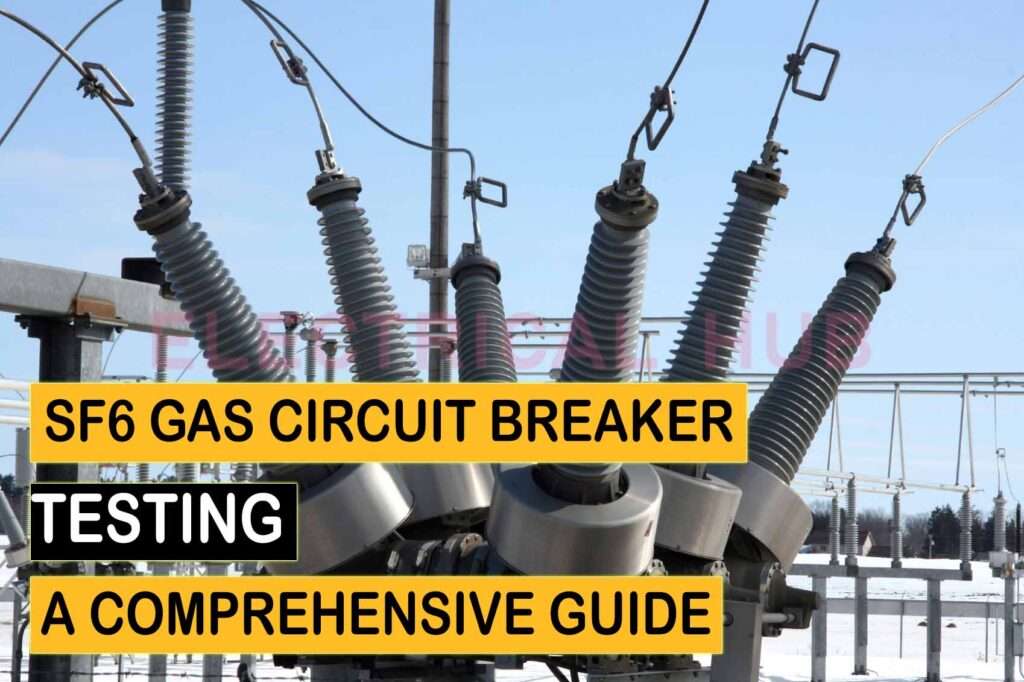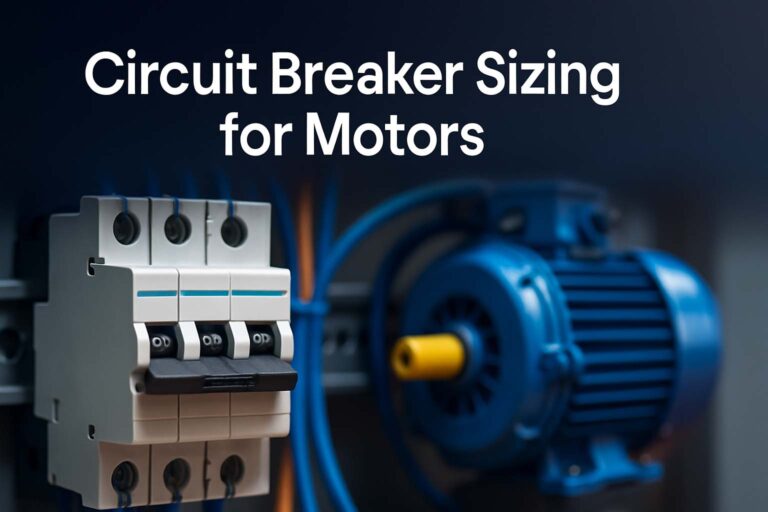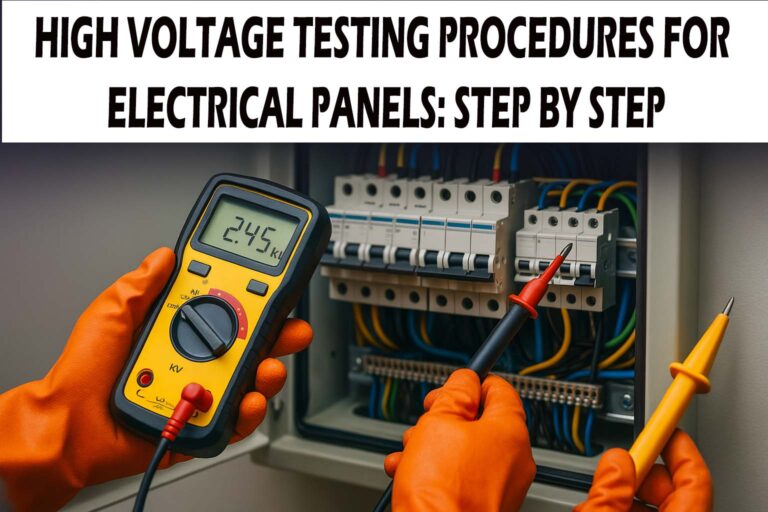SF6 Gas Circuit Breaker Testing: A Comprehensive Guide
SF6 gas circuit breakers are widely used in high-voltage electrical systems due to their superior arc-quenching properties and dielectric strength. Proper testing of SF6 gas circuit breakers ensures their reliability, safety, and performance in critical power systems. This article provides a detailed explanation of SF6 gas circuit breaker testing, covering technical aspects, common methods, and best practices.
Whether you’re preparing for circuit breaker commissioning tests or looking to improve maintenance schedules, this guide will help you understand the critical parameters and procedures involved in SF6 gas circuit breaker testing.

Table of Contents
Table of Contents
Why Test SF6 Gas Circuit Breakers?
SF6 gas circuit breakers operate under extreme conditions, protecting electrical systems from overloads, faults, and short circuits. Testing these breakers is crucial for:
- Ensuring Safety: Faulty breakers can fail during critical operations, causing catastrophic failures.
- Maintaining Reliability: Regular testing ensures the breaker operates as expected during faults.
- Prolonging Equipment Life: Early detection of issues can reduce wear and tear, minimizing long-term costs.
Key Point: SF6 gas circuit breakers use sulfur hexafluoride (SF6) as an insulating medium, and their performance directly depends on the quality and pressure of the gas.
Voltage Range of SF6 Gas Circuit Breakers
SF6 gas circuit breakers are designed to operate across a wide range of voltage levels, making them suitable for various applications, from medium voltage systems to ultra-high voltage (UHV) systems. The voltage range of SF6 circuit breakers typically spans from 3.6 kV to 1200 kV, with different designs and configurations optimized for specific operational needs.
Use our online tool for free Circuit Breaker Size Calculator
1. Medium Voltage (3.6 kV to 36 kV)
SF6 gas circuit breakers in the medium voltage range are primarily used in industrial and commercial power distribution systems. These breakers are compact, cost-effective, and capable of handling fault conditions in distribution networks.
Applications:
- Industrial facilities.
- Commercial buildings.
- Small-scale renewable energy plants.
Advantages in Medium Voltage:
- High reliability in arc quenching.
- Low maintenance requirements compared to vacuum circuit breakers.
2. High Voltage (36 kV to 245 kV)
In the high-voltage range, SF6 gas circuit breakers are commonly deployed in transmission substations to interrupt fault currents and isolate faulty sections of the grid. Their excellent dielectric and arc-extinguishing properties make them a preferred choice for high-voltage applications.
Applications:
- Power transmission networks.
- Substations for regional power distribution.
Technical Features:
- Enhanced arc quenching capability, even at high voltages.
- Designed to handle higher short-circuit currents.
3. Extra High Voltage (245 kV to 765 kV)
SF6 gas circuit breakers for extra-high voltage applications are used in interregional and cross-country transmission systems. These breakers are engineered to manage massive fault currents while maintaining system stability.
Applications:
- Long-distance power transmission lines.
- Integration of large power generation plants (e.g., hydropower, thermal power).
Key Characteristics:
- Ability to handle high-energy interruptions.
- Superior insulation performance, even under harsh environmental conditions.
4. Ultra High Voltage (765 kV to 1200 kV)
SF6 circuit breakers in the ultra-high voltage range are used in advanced power systems, such as those found in countries with robust electrical infrastructure like China, India, and Japan. These systems require breakers capable of withstanding extreme electrical stresses and ensuring rapid fault clearance.
Applications:
- UHV AC and DC transmission networks.
- Grid interconnections for bulk power transfer.
Design Considerations:
- Modular designs to reduce the size and weight of breakers at ultra-high voltages.
- Use of advanced insulation techniques to maintain safety and performance.
Benefits of SF6 Gas Circuit Breakers Across Voltage Ranges
Superior Dielectric Strength: SF6 gas provides a dielectric strength approximately 2.5 times greater than air, ensuring reliable operation across all voltage levels.
Effective Arc Quenching: The rapid recombination of SF6 gas post-arc extinction ensures minimal contact wear, even under high fault currents.
Compact Design: SF6 gas circuit breakers are more compact than air or oil circuit breakers, making them suitable for high-voltage and space-constrained installations.
Low Noise and Emissions: SF6 gas ensures silent operation, making it ideal for installations near urban areas.
Choosing the Right SF6 Gas Circuit Breaker for Your Application
The voltage range of the SF6 gas circuit breaker determines its suitability for specific applications. For example:
Medium voltage systems may prioritize cost and compactness.
High-voltage systems require greater short-circuit handling capability.
UHV systems demand exceptional insulation and modular design for large-scale power transmission.
Types of SF6 Gas Circuit Breaker Testing
The following testing methods are commonly employed:
1. Visual and Mechanical Inspection
Before testing begins, it’s essential to inspect the circuit breaker for physical damage, loose connections, or corroded components. Key areas to check include:
- External housing and seals.
- Operating mechanism and alignment.
- Gas pressure and density gauges.
2. SF6 Gas Analysis
The quality of SF6 gas determines the performance of the breaker. Testing involves:
- Moisture Content Testing: Excess moisture can reduce the dielectric strength of SF6 gas.
- Gas Purity Testing: SF6 gas should have a purity level above 97% for optimal performance.
- Decomposition Product Testing: SF6 gas breaks down under high temperatures, creating harmful by-products. Testing ensures these are within acceptable limits.
3. Contact Resistance Testing
Contact resistance is a vital parameter that ensures the smooth operation of the circuit breaker. Higher resistance indicates wear or contamination of contacts, which can lead to overheating or failures.
Procedure: A micro-ohmmeter is used to measure resistance across the contacts, and results are compared against manufacturer standards.
4. Timing Test
Timing tests verify the breaker’s ability to open and close within specified time limits during faults. Timing discrepancies can indicate issues with the operating mechanism or control circuit.
Equipment Used: A circuit breaker analyzer testing equipment records operating times for:
- Opening.
- Closing.
- Contact bounce.
- Total operation time.
5. Dynamic Resistance Measurement (DRM)
DRM measures the resistance of contacts during operation, providing insights into the wear and condition of the arcing contacts. This test is more accurate than static resistance testing.
6. High Voltage Withstand Test
This test checks the insulation strength of the SF6 gas and other insulating components. A high voltage is applied to the breaker to ensure no breakdown occurs.
Step-by-Step Testing Procedure for SF6 Gas Circuit Breakers
1. Preparation
- De-energize the breaker and isolate it from the system.
- Ensure the breaker is in a stable position and safety measures are in place.
2. Inspection
Conduct a thorough visual and mechanical inspection to identify physical damage or misalignment.
3. SF6 Gas Testing
- Use specialized equipment to measure gas pressure, purity, and moisture content.
- Record gas density to ensure it meets manufacturer specifications.
4. Electrical Testing
- Perform contact resistance testing using a micro-ohmmeter.
- Conduct timing tests to measure opening and closing times.
- Execute high voltage withstand tests to verify insulation integrity.
5. Operational Testing
- Test the mechanical operation of the breaker, ensuring smooth opening and closing without delays.
- Use a circuit breaker test button to simulate operations under different fault conditions.
6. Final Report
- Document all test results and compare them with manufacturer specifications.
- Identify any deviations and recommend corrective actions.
Common Issues Identified During SF6 Gas Circuit Breaker Testing
Gas Leakage: Leakage of SF6 gas reduces insulation strength and disrupts breaker operation.
Corroded Contacts: Worn or oxidized contacts increase resistance, leading to overheating.
Slow Response: Delayed opening or closing times may indicate problems in the operating mechanism.
Gas Contamination: Moisture or decomposition products in the gas reduce its dielectric properties.
Importance of Circuit Breaker Maintenance
SF6 gas circuit breaker testing is part of a broader maintenance strategy. Incorporating regular testing ensures compliance with circuit breaker testing requirements and improves system reliability. In industries where uptime is critical, partnering with the top circuit breaker testing companies in the USA can ensure the highest standards of safety and performance.
Essential Tools for SF6 Gas Circuit Breaker Testing
Testing SF6 gas circuit breakers requires specialized equipment, including:
- Gas Analyzers: For testing purity, moisture, and decomposition products.
- Micro-Ohmmeters: For contact resistance measurements.
- Circuit Breaker Analyzers: For timing and dynamic resistance testing.
- High Voltage Testers: For insulation strength testing.
Pro Tip: Investing in advanced circuit breaker analyzer testing equipment improves testing accuracy and saves time during diagnostics.
Conclusion
Testing SF6 gas circuit breakers is a critical task for maintaining the safety and reliability of high-voltage electrical systems. By conducting regular tests such as contact resistance testing, timing tests, and SF6 gas analysis, operators can ensure optimal performance and avoid costly breakdowns.
For a seamless testing experience, it’s essential to follow standardized circuit breaker testing procedures and utilize the right tools. Whether you’re an electrical engineer or a technician, understanding these tests can help you maintain the integrity of your power systems.
Learn more about circuit breaker testing methods, and don’t forget to explore circuit breaker commissioning tests for a complete understanding of system diagnostics.
Follow Us on Social:
Subscribe our Newsletter on Electrical Insights for latest updates from Electrical Engineering Hub
#SF6Gas, #CircuitBreakerTesting, #SF6CircuitBreaker, #ElectricalTesting, #HighVoltageTesting, #SF6GasSafety, #CircuitBreakerGuide, #ElectricalEngineering, #PowerSystems, #ElectricalTestingGuide, #SwitchgearMaintenance, #SF6Testing, #EnergyDistribution, #ElectricalSafety, #HVTesting





